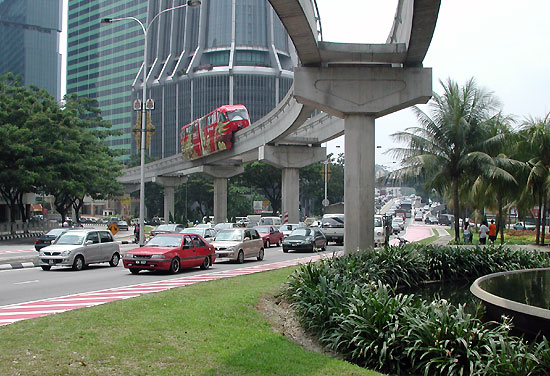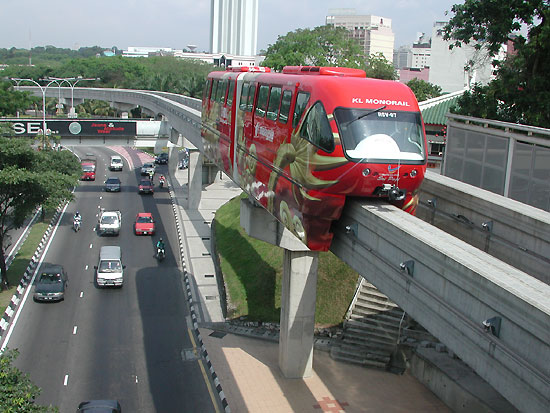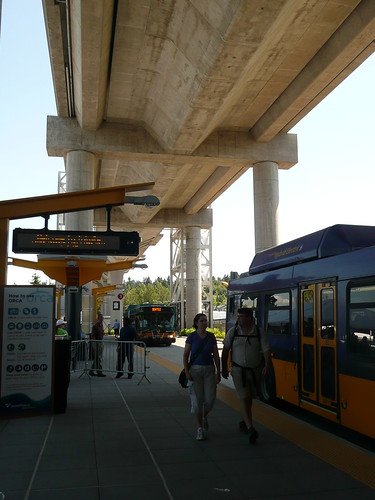I hope this is the correct section.
Here is the situation as it currently stands:
I have 2 mass transport corridors both suffer from extreme overcrowding.
Corridor 1 is about 20 km long
Corridor 2 is about 35 km long
Currently they are serviced by very high frequency bus services which are at the maximum physical capacity or about 100 people per bus. The buses operate almost on a constant basis with buses passing every 30 seconds or less.
Between 6.30am and 9.30 and 2.30pm and 8pm Monday to Friday the passengers around the merging point of the two corridors about 5km from the city struggle to physically get on the bus and often have to use motorbike taxis or car taxis to finish there trip.
The average density of corridor 2 is around 50000 people per sq km and is only serviced by a 3 lane main road with no bus lanes. The entire corridor is built up with buildings of 5 to 15 levels with no option to make the road wider.
The average density of corridor 1 is around 35000 people per sq km and is serviced by a 4 lane road also with no bus lanes.
The two main roads merge at a large 5 lane wide traffic circle also this traffic circle is the terminus of a commuter railway that is physically isolated from the rest of the system forcing up to 2500 people per hour into the most congested part of the 2 corridors.
All of this traffic is then force over a 4 lane wide bridge to junction where 80% of the traffic must turn right on to a 2 lane wide road in an area that is so densely built up that people have to take over parts of the traffic road just to walk through. The average density in this area hits 100000 per sq km and is made up of densely packed 6 to 20 story buildings.
The corridor ends at a major railway station with both commuter rail and metro line on a 10 lane wide road. which is also a highly congested area.
The estimated hourly throughput on corridor 1 is around 20000 people and corridor 2 is around 35000 people per hour and this merges together with a throughput of 55000 people per hour.
Every one of these people are crammed into hundreds of buses that form an almost continuous line along most of the corridor. Traveling times for corridor 2 is around 2.5 hours end to end and 90 to 120 mins for corridor 1. Which is far too slow as its half this time off peak and a quarter of it at night.
The main reason I'm writing all this is to see if anyone might have some ideas of how to ease this massive congestion and increase capacity of the 2 corridors as cheaply and as fast as possiable.
I have to deal this overloading on a daily basis with no end insight and there are more and more new large condo towers being built along the corridors just make things even worse for everyone.
Here is the situation as it currently stands:
I have 2 mass transport corridors both suffer from extreme overcrowding.
Corridor 1 is about 20 km long
Corridor 2 is about 35 km long
Currently they are serviced by very high frequency bus services which are at the maximum physical capacity or about 100 people per bus. The buses operate almost on a constant basis with buses passing every 30 seconds or less.
Between 6.30am and 9.30 and 2.30pm and 8pm Monday to Friday the passengers around the merging point of the two corridors about 5km from the city struggle to physically get on the bus and often have to use motorbike taxis or car taxis to finish there trip.
The average density of corridor 2 is around 50000 people per sq km and is only serviced by a 3 lane main road with no bus lanes. The entire corridor is built up with buildings of 5 to 15 levels with no option to make the road wider.
The average density of corridor 1 is around 35000 people per sq km and is serviced by a 4 lane road also with no bus lanes.
The two main roads merge at a large 5 lane wide traffic circle also this traffic circle is the terminus of a commuter railway that is physically isolated from the rest of the system forcing up to 2500 people per hour into the most congested part of the 2 corridors.
All of this traffic is then force over a 4 lane wide bridge to junction where 80% of the traffic must turn right on to a 2 lane wide road in an area that is so densely built up that people have to take over parts of the traffic road just to walk through. The average density in this area hits 100000 per sq km and is made up of densely packed 6 to 20 story buildings.
The corridor ends at a major railway station with both commuter rail and metro line on a 10 lane wide road. which is also a highly congested area.
The estimated hourly throughput on corridor 1 is around 20000 people and corridor 2 is around 35000 people per hour and this merges together with a throughput of 55000 people per hour.
Every one of these people are crammed into hundreds of buses that form an almost continuous line along most of the corridor. Traveling times for corridor 2 is around 2.5 hours end to end and 90 to 120 mins for corridor 1. Which is far too slow as its half this time off peak and a quarter of it at night.
The main reason I'm writing all this is to see if anyone might have some ideas of how to ease this massive congestion and increase capacity of the 2 corridors as cheaply and as fast as possiable.
I have to deal this overloading on a daily basis with no end insight and there are more and more new large condo towers being built along the corridors just make things even worse for everyone.
Thai Mass Transport Systems http://thaitransit.blogspot.com/








